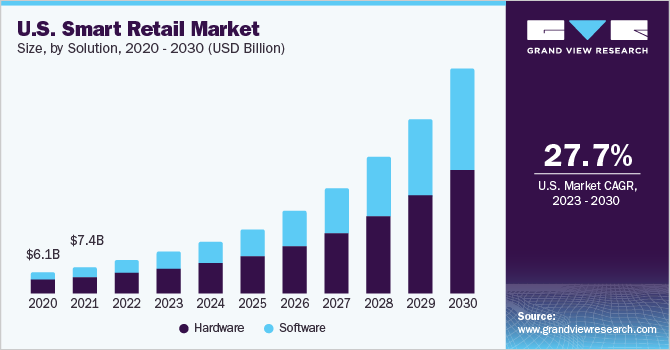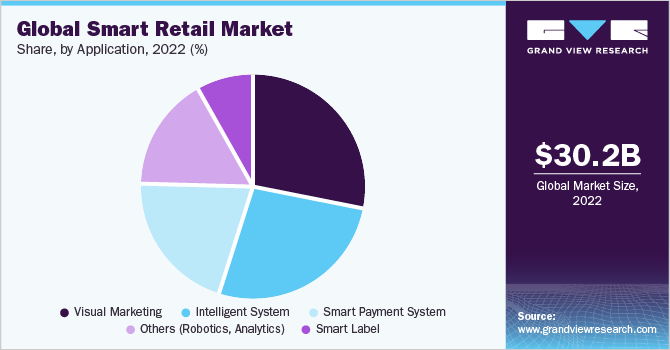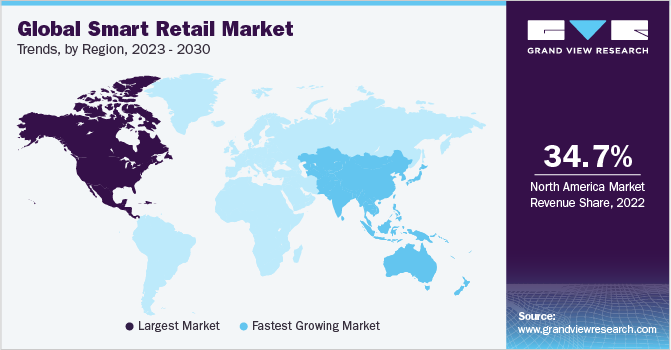- Home
- »
- Next Generation Technologies
- »
-
Smart Retail Market Size, Share And Trends Report, 2030GVR Report cover
![Smart Retail Market Size, Share & Trends Report]()
Smart Retail Market Size, Share & Trends Analysis Report By Solution (Hardware, Software), By Application (Visual Marketing, Smart Label, Smart Payment System, Intelligent System), By Region, And Segment Forecasts, 2023 - 2030
- Report ID: GVR-2-68038-588-5
- Number of Report Pages: 150
- Format: PDF, Horizon Databook
- Historical Range: 2018 - 2021
- Forecast Period: 2023 - 2030
- Industry: Technology
Smart Retail Market Size & Trends
The global smart retail market size was valued at USD 30.25 billion in 2022 and is expected to grow at a compound annual growth rate (CAGR) of 29.1% from 2023 to 2030. The growing incorporation of technologies such as Artificial Intelligence (AI), Virtual Reality (VR), Augmented Reality (AR), and the Internet of Things (IoT) to enhance consumers’ shopping experience, facilitate accurate inventory management, and improve store operations is one of the significant trends escalating the market growth. AR is particularly transforming the retail industry by allowing brands to interact with consumers through their mobile devices. The adoption of AR in marketing helps in building consumer relationships, enhancing the customer experience, and subsequently driving sales. For instance, Airwalk, a shoe brand, uses AR and geolocation to create a virtual pop-up shop, thereby promoting the relaunch of Airwalk Jim. A significant increase in the number of retail stores across various geographies is also driving the demand for advanced technologies.

Smart retail is a cost-effective and profit-making process for consumers and retailers due to improved supply chain management. However, the impact of COVID-19 has been adverse on the supply chain of smart retail, hampering the movement of goods due to logistics and travel restrictions. Deliveries have been deferred for retailers as well as consumers. This effect on the supply chain stays temporary as things are gradually getting back to normal with safety measures. In the long term, a smart retail supply chain will play a vital role. The smart retailing industry, which had registered a healthy CAGR even before the pandemic, has grown steeply since the COVID-19 outburst. As the pandemic situation is uncertain and cannot be anticipated for the coming months, safety measures levied by regulatory bodies are varying rapidly. Contactless operations and social distancing are enabling consumers to access substitute retailing solutions; this is where smart retail plays a vital role in daily life.
Many retailers, especially SMEs, lack the commercial resources to finance advanced business platforms. There is a rising settlement in the industry that stores must continue to digitize with IoT devices and focus on offering better shopping experiences to stay competitive and attract customers back to stores. Apart from the pandemic situation, smart retail advancements are also assisting the industry in gaining higher demand, for instance, by buying finished goods through the voice process. This AI-based smart retail will ease the buying process and increase the adoption rate. Companies are now rising with situations and changing operations by adopting digital technology and smart retailing services. Smart retail industry players, from small to mega-vendors, are realizing the importance of smart retailing and implementing digital solutions for a better customer experience. Apart from large-scale smart retailing vendors such as Alibaba and Amazon, small-scale players also aim to tap into this opportunity. For instance, mobile manufacturer Vivo launched Vivo Smart Retail to help retailers see the demand for smartphones using its smart retail network in India. Moreover, Amazon and IKEA are using AR-Kit for visualizing their furniture at the user’s desired location.
In recent years, digital payment modes, such as debit cards, credit cards, prepaid cards, electronic wallets, and other digital platforms, are expected to witness significant traction over the forecast period. The shifting consumer preference to cashless transactions and the subsequent increase in the adoption of digital payment solutions across retail stores, including specialty stores, supermarkets, and departmental stores, are particularly expected to drive the growth of the market over the forecast period.
Digitalization can benefit retailers in the form of new customers and reduced operational costs, among other benefits. Digitalization can also be highly motivating for retailers’ employees. Subsequently, digitalization can help in augmenting revenues. Non-store retailing witnessed significant growth in 2020. Developments in technology, improved connectivity, the advent of innovative sensors, and the availability of seamless communication solutions are anticipated to aid online retail stores thereby contributing significantly to the growth of the market over the forecast period.
Solution Insights
The hardware segment accounted for the largest market share of 65.11% in 2022. Based on solution, the market is segmented into hardware and software. The growing application of Augmented Reality (AR) and Virtual Reality (VR) devices, point of sale (POS) systems, Bluetooth beacons, and Radio-frequency identification (RFID) systems to offer a seamless in-store shopping experience to customers is augmenting the growth of the segment.
The software segment is anticipated to grow at a CAGR of 30.7% during the forecast period. Increasing the adoption of analytics software by retailers across the world, to understand specific end-user’s needs and behavior to improve customer engagement and the shopping experience is one of the crucial factors stimulating the growth of the segment. The need to analyze the changing consumer preferences and put a strong emphasis on customer-centric marketing is also growing in line with the rising retail investment. This is anticipated to create immense opportunities for analytics in smart retailing.
Application Insights
The virtual marketing segment accounted for a market share of 28.31% in 2022. Based on application, the is segmented into visual marketing, smart label, smart payment system, intelligent system, and others (robotics, analytics). Retailers are also considering visual marketing through appealing storefronts, digital signage, interior displays, and state-of-the-art lighting as one of the essential requirements for a smart retail solution to engage customers. Moreover, social media marketing has particularly helped in attracting the millennial population. It has enabled retailers to focus on providing a smooth shopping experience with minimal interference from social media. Hence, in 2020 visual marketing accounted for the majority share of the market. Furthermore, the growth of the e-commerce industry has also opened several opportunities for brick-and-mortar stores. Such stores are utilizing visual marketing for their products and offerings in the form of product snapshots and videos to engage customers and gain traction on e-commerce websites.

The smart payment system segment is anticipated to grow at a CAGR of 30.1% during the forecast period. The smart payment system segment is projected to witness considerable growth over the forecast period. The surge can be attributed to the initiatives being followed to promote digital payments and the increasing need to enhance the customer experience. Besides, a significant increase in cashless transactions is driving the need for POS solutions, e-payment systems, mobile payment apps, and other payment systems. The notable growth in the usage of mobile wallets is also expected to drive the growth of the segment over the forecast period.
Regional Insights
North America held the major share of 34.70% of the target market in 2022. This region is anticipated to be the leading revenue contributor in the market throughout the forecast period. The growing demand for luxury goods and premium items and the rapidly-changing customer preferences for more convenient and less time-intensive retail experiences. The increasing adoption of digital technology across every application area is restructuring the U.S. economy. The post-pandemic effect has impacted the retail industry by digitally transforming businesses faster than previously planned.

Asia Pacific is anticipated to grow as the fastest-developing regional market at a CAGR of 30.7%. The growing application of smart retail solutions such as big data analytics, intelligent dressing mirrors, reception robots, and shopping guide robots in countries such as Japan and China is expected to drive regional market growth. Apart from big smart retailing players such as Alibaba and Amazon, smaller providers also plan to tap into this opportunity.
Key Companies & Market Share Insights
The key players operating in the smart retail market are broadening their product offerings, while utilizing a variety of inorganic growth tactics, such as partnerships, regular mergers, and acquisitions. In May 2022, Amazon launched Smart Commerce in India to enable offline retailers to launch their digital storefronts and offer enhanced services to customers. The initiative will also help retailers offer their customers an in-store shopping experience. Some prominent players dominating the global smart retail market include:
-
Amazon.com, Inc.
-
Cisco Systems, Inc.
-
Google LLC
-
Honeywell International Inc.
-
Huawei Technologies Co., Ltd.
-
IBM Corporation
-
Ingenico, Fiserv, Inc.
-
Intel Corporation
-
LG Display Co., Ltd.
-
NCR Corporation
-
NVIDIA Corporation
-
NXP Semiconductors
-
PAX Global Technology Limited
-
Samsung Electronics
-
Verifone Systems
Smart Retail Market Report Scope
Report Attribute
Details
Market size value in 2023
USD 38.09 billion
Revenue forecast in 2030
USD 227.29 billion
Growth Rate
CAGR of 29.1% from 2023 to 2030
Base year for estimation
2022
Historical data
2018 - 2021
Forecast period
2023 - 2030
Report updated
June 2023
Quantitative units
Revenue in USD billion and CAGR from 2023 to 2030
Report coverage
Revenue forecast, company market share, competitive landscape, growth factors, and trends
Segments covered
Solution, application, region
Regional scope
North America; Europe; Asia Pacific; Latin America; Middle East & Africa
Country scope
U.S.; Canada; Germany; UK; France; Italy; Spain; China; India; Japan; South Korea; Australia; Brazil; Mexico; Argentina; U.A.E.; Saudi Arabia; South Africa
Key companies profiled
Amazon.com, Inc.; Cisco Systems, Inc.; Google LLC; Honeywell International Inc.; Huawei Technologies Co., Ltd.; IBM Corporation; Ingenico; Fiserv, Inc.; Intel Corporation; LG Display Co., Ltd.; NCR Corporation; NVIDIA Corporation; NXP Semiconductors; PAX Global Technology Limited; Samsung Electronics; Verifone Systems
Customization scope
Free report customization (equivalent up to 8 analysts working days) with purchase. Addition or alteration to country, regional & segment scope.
Pricing and purchase options
Avail customized purchase options to meet your exact research needs. Explore purchase options
Global Smart Retail Market Report Segmentation
This report forecasts revenue growth at global, regional, and country levels and provides an analysis of the latest industry trends in each of the sub-segments from 2018 to 2030. For this study, Grand View Research has segmented the global smart retail market based on solution, application, and region.
-
Solution Outlook (Revenue, USD Billion, 2018 - 2030)
-
Hardware
-
Software
-
-
Application Outlook (Revenue, USD Billion, 2018 - 2030)
-
Visual Marketing
-
Smart Label
-
Smart Payment System
-
Intelligent System
-
Others (Robotics, Analytics)
-
-
Regional Outlook (Revenue, USD Billion, 2018 - 2030)
-
North America
-
U.S.
-
Canada
-
-
Europe
-
UK
-
Germany
-
France
-
Italy
-
Spain
-
-
Asia Pacific
-
China
-
India
-
Japan
-
Australia
-
South Korea
-
-
Latin America
-
Brazil
-
Mexico
-
Argentina
-
-
Middle East & Africa
-
U.A.E
-
Saudi Arabia
-
South Africa
-
-
Frequently Asked Questions About This Report
b. The global smart retail market size was estimated at USD 30.25 billion in 2022 and is expected to reach USD 38.09 billion in 2023.
b. The global smart retail market is expected to grow at a compound annual growth rate of 29.1% from 2023 to 2030 to reach USD 227.29 billion by 2030.
b. North America dominated the smart retail market with a share of 28.0% in 2020. The strong presence of smart retail solution providers and heightened adoption of advanced ICT technology in the retail sector is poised to augur well for the growth of the regional market.
b. Some key players operating in the smart retail market include Amazon.com, Inc., Cisco Systems, Inc., Google LLC, Honeywell International Inc., Huawei Technologies Co., Ltd., IBM Corporation, Ingenico, Fiserv, Inc., Intel Corporation, LG Display Co., Ltd., NCR Corporation, NVIDIA Corporation, NXP Semiconductors, PAX Global Technology Limited, Samsung Electronics, and Verifone Systems.
b. Key factors that are driving the smart retail market growth include the growing incorporation of technologies such as augmented reality, virtual reality, artificial intelligence, and IoT to improve store operations, facilitate accurate inventory management, and enhance consumer’s shopping experience.
Share this report with your colleague or friend.
![gvr icn]()
NEED A CUSTOM REPORT?
We can customize every report - free of charge - including purchasing stand-alone sections or country-level reports, as well as offer affordable discounts for start-ups & universities. Contact us now
![Certified Icon]()
We are GDPR and CCPA compliant! Your transaction & personal information is safe and secure. For more details, please read our privacy policy.
We are committed towards customer satisfaction, and quality service.
"The quality of research they have done for us has been excellent."





